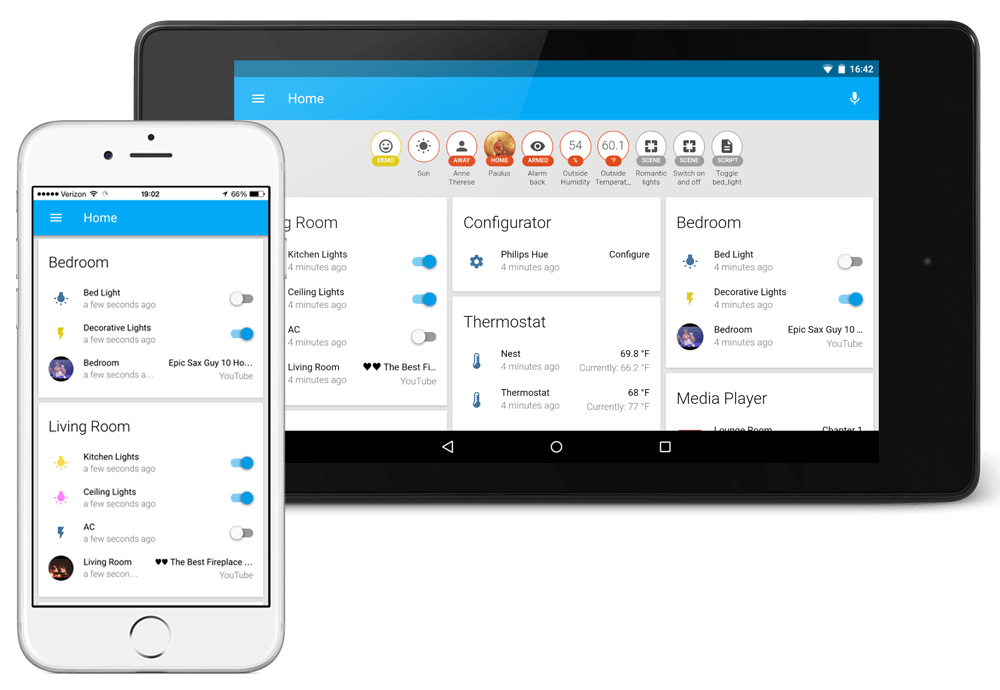0.7: Better UI and improved distribution
As Home Assistant is gaining more and more users we started to feel the pain from not having a proper release mechanism. We had no version numbering and required users to checkout the source using Git to get started. On top of that, as the number of devices that we support keeps raising, so did the number of dependencies that are used. That’s why we decided to change the way we roll. From now on:
- Each release will have a version number, starting with version 0.7. This was chosen because it shows that we have been around for some time but are not considering ourselves to be fully stable.
- Each release will be pushed to PyPi. This will be the only supported method of distribution.
- Home Assistant is available after installation as a command-line utility
hass. - The default configuration location has been moved from
configin the current working directory to~/.homeassistant(%APPDATA%/.homeassistanton Windows). - Requirements for components and platforms are no longer installed into the current Python environment (being virtual or not) but will be installed in
<config-dir>/lib.
A huge shout out to Ryan Kraus
And while Ryan was fixing distribution, I have been hard at work in giving Home Assistant a face lift. We already looked pretty good but lacked proper form of organization for users with many devices. The new UI moves away from a card per entity and has cards per group and domain instead. The demo has been updated so give it a spin.
Migration to version 0.7
For this example, let’s say we have an old Home Assistant installation in /home/paulus/home-assistant.
If you want to migrate your existing configuration to be used as the default configuration:
cp -r /home/paulus/home-assistant ~/.homeassistant
It If you want to have the configuration in a different location, for example /home/paulus/home-assistant-config, you will have to point Home Assistant at this configuration folder when launching:
hass --config /home/paulus/home-assistant-config
New platforms
And last, but not least: new platforms!
MQTT Sensors and Switches
 @sfam
@sfam
# Example configuration.yaml entry
sensor:
platform: mqtt
name: "MQTT Sensor"
state_topic: "home/bedroom/temperature"
unit_of_measurement: "°C"
switch:
platform: mqtt
name: "Bedroom Switch"
state_topic: "home/bedroom/switch1"
command_topic: "home/bedroom/switch1/set"
payload_on: "ON"
payload_off: "OFF"
optimistic: false
Actiontec MI424WR Verizon FIOS Wireless router
 Nolan
Nolan
# Example configuration.yaml entry
device_tracker:
platform: actiontec
host: YOUR_ROUTER_IP
username: YOUR_ADMIN_USERNAME
password: YOUR_ADMIN_PASSWORD
DHT temperature and humidity sensors @MakeMeASandwich has contributed support for DHT temperature and humidity sensors. It allows you to get the current temperature and humidity from a DHT11, DHT22, or AM2302 device.
# Example configuration.yaml entry
sensor:
platform: dht
sensor: DHT22
pin: 23
monitored_conditions:
- temperature
- humidity
Aruba device tracker
Michael Arnauts
# Example configuration.yaml entry
device_tracker:
platform: aruba
host: YOUR_ACCESS_POINT_IP
username: YOUR_ADMIN_USERNAME
password: YOUR_ADMIN_PASSWORD
